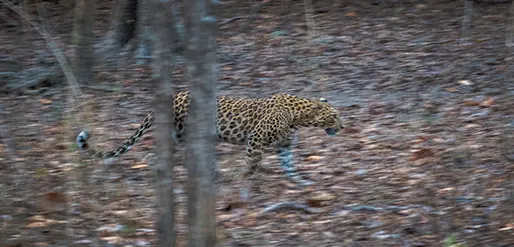The nearest major railway station to Pench National Park is Nagpur Junction, located approximately 92 kilometers away. From Nagpur, you can take a taxi or hire a private vehicle to reach Pench National Park. Nagpur is well-connected to several major cities in India, making it a convenient railway hub for travelers.
Pench National Park


Pench National Park
-
Duration
3 to 5 days
-
Max People
40
-
Tour Type
Wildlife Safari
-
Min Age
1+
About this Tour
Pench National Park, nestled in the enchanting landscapes of Madhya Pradesh, served as the muse for the literary brilliance of Sir Rudyard Kipling. It was within the lush confines of this park that Kipling drew inspiration for his timeless masterpiece, The Jungle Book. The iconic wolf child of the story, later immortalized as Mowgli, echoes the real-life account of a human child nurtured by wolves in the Seonee (now Seoni) district during the nineteenth century. Explore the captivating allure of Pench, where nature and literature converge to create a truly magical experience.
-
Sprawling Wilderness: Pench National Park covers an expansive area of 1200 sq. km., extending across the states of Madhya Pradesh and Maharashtra.
-
Interstate Marvel: The Totladoh Dam, a hydroelectric project, was constructed on the Pench river between 1973 and 1988. This marked the pioneering interstate collaboration between Madhya Pradesh and Maharashtra. The dam submerged approximately 72 sq. km, with 54 sq. km within Pench National Park M.P. and the remainder in Maharashtra.
-
Core Zone Entrances: The Core zone of Pench National Park features three gates: Turia gate, Karmajheri gate, and Jamtara gate. Each entrance promises unique wildlife encounters and scenic landscapes.
-
Maharashtra's Tiger Haven: The Maharashtra section of Pench, officially designated as a Tiger Reserve in 1999, spans around 257 sq. km. The Maharashtra side boasts popular entry points like Sillari and Khursapar, offering memorable experiences for visitors.
-
Gateway Variety: In addition to Turia, Karmajheri, and Jamtara gates in Madhya Pradesh, Pench Tiger Reserve on the Maharashtra side features several entry points, including Saleghat, Kolitmara, Chorbahuli, and Surewani. Each gateway introduces visitors to distinct facets of the reserve.
-
Holistic Conservation: Pench Tiger Reserve comprises the holistic union of “Indira Priyadarshini Pench National Park, Pench Mowgli Sanctuary, and the buffer forest.” This comprehensive approach ensures the preservation and sustainable management of the diverse ecosystems within the reserve.

-
Diverse Flora and Fauna: Pench National Park boasts a remarkable variety of flora and fauna, creating a biodiverse haven. Visitors can encounter a wide range of plant species, including teak, mahua, and bamboo, providing a vibrant backdrop to the diverse animal life.
-
Expansive Territory: Covering an extensive area of 1200 sq. km., Pench is a sprawling wilderness that spans both Madhya Pradesh and Maharashtra. This vast expanse contributes to the park's ability to sustain a rich and varied ecosystem.
-
Gateway Variety: Accessing Pench's wonders is facilitated through multiple entry points. The park's core, which includes Turia gate, Karmajheri gate, and Jamtara gate, offers diverse experiences for wildlife enthusiasts, providing access to different regions of the park.
-
Vegetation Types: Pench's landscape is characterized by a mix of tropical dry deciduous forest, tropical moist deciduous forest, and open grasslands. This variety in vegetation types contributes to the park's ecological richness, providing habitats for a wide range of plant and animal species.
-
Maharashtra's Tiger Territory: The Maharashtra side of Pench, officially designated as a Tiger Reserve, serves as a crucial habitat for tigers. This section of the park, spanning approximately 257 sq. km., features gates like Sillari and Khursapar, providing unique opportunities to observe the park's majestic feline residents.
-
Gateway to Unique Species: Pench's multiple gates, such as Saleghat, Kolitmara, Chorbahuli, and Surewani, open doors to encounters with a variety of wildlife. The park's flora includes medicinal plants, grasses, and indigenous trees, contributing to the overall biodiversity of the region.
-
Holistic Conservation Approach: The park's commitment to conservation is reflected in its comprehensive approach, encompassing "Indira Priyadarshini Pench National Park, Pench Mowgli Sanctuary, and the buffer forest." This ensures the preservation of diverse vegetation types and their associated fauna, promoting a balanced and sustainable ecosystem.
Note: It's recommended to check the current transportation options and schedules as they may be subject to change. Additionally, consider booking your train or flight tickets in advance to ensure availability, especially during peak travel seasons.
Itinerary
-
Reaching Pench National Park by Train:
-
Reaching Pench National Park by Flight:
The nearest airport to Pench National Park is the Dr. Babasaheb Ambedkar International Airport in Nagpur. Once you arrive at the airport, you can hire a taxi or use other local transportation to reach Pench National Park, which is approximately a 2-3 hour drive from the airport
Alternative Airport: Another option is the Jabalpur Airport, which is approximately 200 kilometers away from Pench National Park. Depending on your travel plans and flight availability, you can consider flying to Jabalpur and then taking a taxi or private transport to Pench.

